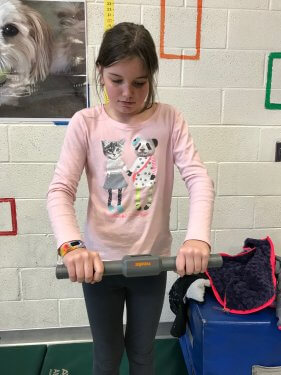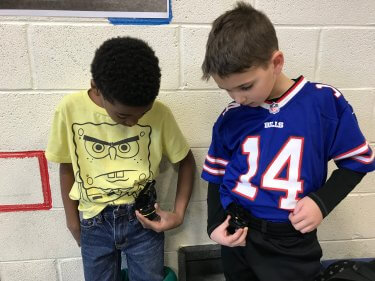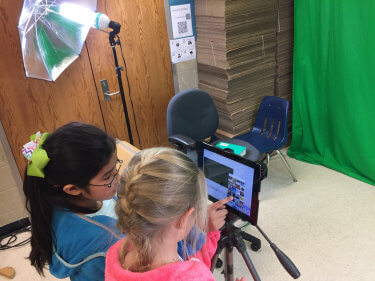My recent Christmas experience got me thinking. After both giving and receiving presents I started wondering: Were the presents I gave others close to what they really wanted? Were the gifts I received what I wanted or at least useful?
“Usefulness “struck me as an interesting way of thinking about gift giving. Some gifts are genuinely useful while others are momentarily amusing, but soon get put aside, remain unused, and are eventually discarded or given to others. This soon had me thinking about the items physical educators seek out or are given by others to support our teaching. Specifically, I started to think about the usefulness of “technology”? How genuinely useful is technology? Is it a useful tool, or an entertaining toy?

Today, there’s so much out there for teachers to choose from. It can quickly become really mind-boggling. For me, it all comes down to how you plan to use it. I think it’s time for all teachers to get past the use of technology as a toy: to simply use it so that we can say that we use technology in our teaching.
If technology is just a toy we use because our students enjoy using it, or so that we can tell our administrators that are using technology, we’re shortchanging both our students and ourselves. But if we are using technology because it makes our teaching more effective and our students’ better learners, then we’re onto something good! A good rule of thumb is: if your kids can learn more while using it, then use it, if not, then don’t.

Take heart rate monitors as an example. If we use them to have the kids take their heart rates, that’s great to a point. But it’s the next step that’s important. What are you going to do with that information? How are you going to use those student heart rates to help your kids learn more than just having them manually take their own pulse? If it’s just “What’s your heart rate? Now move to the next station,” you’re missing a teaching opportunity. What will you have them do with that data? Will they write it down? Okay, now what? What are you planning for them to do with those numbers? Even if you have them graph their heart rates, how will you guide them through interpreting their personal graphs?
It’s here where the real learning comes in. You see it’s not just the fact that they used heart rate monitors in your class that day, or that week. It’s what they did with the technology that’s important. How did you help them use that information on themselves to connect exercise with their own health and fitness?
Going a step further you could have them graph their heart rates using a spreadsheet like Excel. Now they have a pretty looking graph. But so what? It all comes down to how you have them use that graph to help them learn. Can they explain to you what all the lines on the graph mean to them? Why were their heart rates different at different stations? Or what would they do next time to increase or decrease their heart rate? Can they explain all of this to another person in class, or can they take it home and explain it to their parents?

Similarly, pedometers are popular with physical educators. The kids just love wearing them! The challenge is how you get your students beyond just seeing how many steps they take. Are you looking to increase activity totals? If so, using tokens from a place like Fitness Finders (https://www.fitnessfinders.net) provides a great motivator! Every 10,000 steps they get a small sneaker medal.
But what if you want your kids to get more out of using this tool. After they record their steps for a few weeks, you can have them examine their totals and begin to introduce them to goal setting. Get them to think about their own activity levels. If they see that they got about 1,500 steps per class over the last few weeks, what would they like to shoot for this week?
You could introduce SMART goals to them: specific, measurable, attainable, relevant and trackable goals. This is a great way to get them to look at themselves and how they can improve, without having them think that they have to compare themselves to someone else to see any improvement. Everyone is challenged at their own level to improve a little bit each week or so.

Consider having your students use pedometers to compare activities to each other. Have them look at their step totals from soccer and compare them to totals from volleyball. Get them thinking why one activity has more steps than another. Does that make one activity bad, better than another, or just different? If steps in volleyball were less than in soccer, you could ask your students how they might modify a volleyball game to result in more steps. I think you’d be surprised on what they come up with!
What about using some other form of technology, for example video? It’s already out there for the kids to use. Some of our elementary kids have their own smartphones. How can we take advantage of this? It’s easy to record students in action in our classes, but what’s next? Do we show it to the kids and that’s all? Do we just say, “Hey look, here you are dribbling a basketball, good job!” Or do we say, “Hey, here you are dribbling the basketball. Tell me what you see? What are you already doing correctly? Is there anything you see that you want to improve?”
Notice how the second line of questioning engages the students in their own learning. You are showing them how to look at themselves to understand what they need to do to improve. Now you are using technology as a tool, instead of a toy.

You can take video a step farther and record your kids in action to create a “highlight reel.” You tell them that the highlight reel will only contains video of students at a certain level of skill performance. You’ve spelled out exactly what you are teaching and what you expect from the kids. Now as you start recording video, you can show it back to them right then and there! Have them look at it and ask them what they see in themselves. What do they see themselves doing correctly, and what if anything, do they see that they want to improve on? Help them to get beyond simply being enthralled by seeing themselves in action.
You can use this strategy to get insight into your students’ level of understanding, as well as their skill level. You can now offer your feedback. You can confirm or redirect their observations. You can say, “You’re right, you do keep your eyes looking down at the ball when you dribble. Let’s see if you can concentrate on looking more where you are going as you practice, so we can get you on the highlight reel later.”
You know darn well that this student will do everything that they can to improve their dribbling to make the highlight reel! Now it’s just a matter of you catching them getting it right and acknowledging them when they get it!
Many times, the kids will be their own worst critics. They will often automatically think they did something wrong when they see themselves. Imagine their face lighting up when you redirect their attention by saying that “your head is up almost all the time. Well done. That’s exactly what you should look like dribbling the ball!”
There are of course so many more ways to use technology in our teaching. I’ve only mentioned a few. And I know that many of you are using technology in some truly amazing instructional ways. So, let’s all of us, no matter what form the technology takes, just make sure that you we use it as a tool to an end, and not as a shiny new toy to briefly play with and soon lose interest.
Happy New Year and have a great 2018!

Some great points Tom that I hope will make teachers think. I will share that although on a different topic your essay made me think about national standards. In my thinking these are also “tools” to support effective teaching rather than something to be “achieved.” It’s absurd to think of any teacher possibly getting ALL of his or her students to “achieve” the national standards. In contrast “50 Million Strong by 2029” had (to my mind at least) a much clearer and in fact achievable goal: Getting all of the students I teach to be regularly physically active and (to the extent possible) in good health. Sadly, I hear too often people using our national standards as if they were our “destination” rather than guides to help us get to our destination. Sometimes I fear an obsession about standards has become our Achilles heel. Just sayin’!!